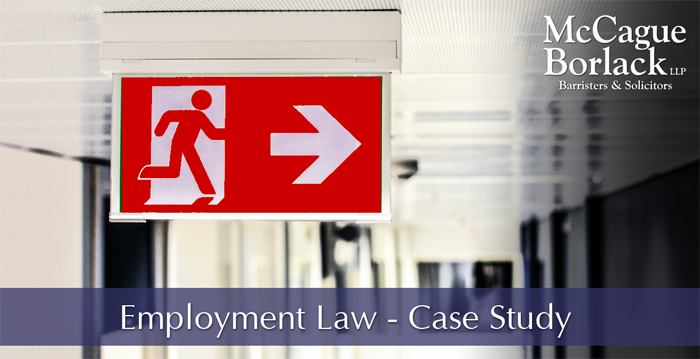by Howard Borlack and Chanpreet Shokar
In Antchipalovskaia v. Guestlogix Inc.,1 released on June 9, 2022, the Ontario Court of Appeal held that in cases where an employee is terminated and subsequently rehired at the time of proceedings under the Companies' Creditors Arrangement Act ("CCAA"), the employee's prior period of employment is relevant in determining what notice period the employee is entitled to.
Background
Ms. Antchipalovskaia commenced employment at Guestlogix in 2011. In February 2016, Guestlogix launched CCAA proceedings and shortly thereafter, a group of investors agreed to purchase all the shares of Guestlogix. The agreement included a condition that the eventual CCAA plan of arrangement would include a term releasing Guestlogix from any employee claims arising before the implementation date.
As part of the CCAA plan, Ms. Antchipalovskaia was told that she would be terminated and immediately rehired in the same position with the same terms beginning on the day following the CCAA plan was implemented. Given the termination of her employment, Ms. Antchipalovskaia was entitled to make a claim in the CCAA proceedings. She submitted a claim for her termination and severance pay entitlements under the Employment Standards Act, 2000, S.O. 2000, c. 41 (the "ESA"). She voted in favour of the CCAA plan and once the CCAA plan was implemented, she received a pro rata entitlement of $13,367.83, representing 72% of her claim.
Guestlogix terminated Ms. Antchipalovskaia's employment in June 2019, which is 2.75 years from the date she was rehired. Guestlogix relied on the "without cause" provision in the employment agreement, which was included in the new employment agreement when Ms. Antchipalovskaia was rehired. This purported to preclude entitlement to common law notice in the event of her termination. As a result, Guestlogix paid Ms. Antchipalovskaia the minimum entitlement under the ESA from her original start date to the date she was terminated, minus the amount she received in the CCAA proceedings.
Ms. Antchipalovskaia brought an action for wrongful dismissal, claiming that she was entitled to common law notice.
Motion Judge's Decision
In a motion for summary judgement, the two issues to be considered by the motions judge were the validity of the "with cause" and "without cause" termination provisions in the employment contract and entitlement to common law notice.
The motions judge held that the termination provisions in the employment contract were invalid... |
The motions judge held that the termination provisions in the employment contract were invalid because they did not comply with the minimum requirements in the ESA. In determining the common law reasonable notice, the motions judge found that Ms. Antchipalovskaia's employment should be treated as continuous from 2011 to 2019. The motions judge noted that the employer issued a Record of Employment that identified the first day of work as July 5, 2011, and calculated Ms. Antchipalovskaia's entitlements on the basis of 7 years and 11 months of employment. The motions judge awarded a 12-month notice period, less the amount of the employee's claim in the CCAA proceedings, and the amounts paid as a result of her termination.
The Appeal
Guestlogix appealed the motion judge's decision to the Ontario Court of Appeal, arguing that the motion judge erred by failing to find that the employee's entitlement to any common law notice for her employment between 2011 and 2016 was released in the CCAA proceedings.
The Court of Appeal allowed the appeal, holding that Ms. Antchipalovskaia was only employed by Guestlogix for 2.75 years, the amount of time she was employed following the implementation of the CCAA plan. However, it was also held that Ms. Antchipalovskaia's employment from 2011 to 2016 should be taken into account in determining her notice period because her prior years of service provided a benefit to Guestlogix.
The Court of Appeal noted that for the purposes of determining ESA entitlements, when an employer sells its business and the purchaser continues to employ an employee of the seller, "the employee shall be deemed not to have been terminated or severed for the purpose of this Act and his or her employment with the seller shall be deemed to have been employed with the purchaser for the purpose of any subsequent calculation of the employee's length or period of employment."2
The Court of Appeal found that the motion judge failed to recognize the "sharp distinction" it had established in its decision of Manthadi v. ASCO Manufacturing,3 which distinguishes the calculation of an employee's length of employment under s. 9(1) of the ESA, and at common law. The ESA is clear that when an employer sells its business and an employee continues to be employed by that purchaser, the employee remains continuously employed. Under the common law, however, employees of the seller are terminated by constructive dismissal and a new period of employment is initiated with the purchaser.
In order to deal with the unique circumstances of each case, the Court of Appeal noted that courts can apply the non-exhaustive list of factors established in Bardal v. Globe & Mail Ltd.,4 which includes the length of time served by the employee.
...it was held that the motion judge erred in treating her employment as continuous... |
The Court of Appeal applied the precedent set by its previous decision of Manthadi to the case at bar, and it was held that the motion judge erred in treating Ms. Antchipalovskaia's employment as continuous from 2011 to 2019. The motion judge also erred by failing to consider the termination of employment and CCAA release. The Court of Appeal ultimately set aside the motion judge's 12-month notice period because it was at the high end of the range for someone with Ms. Antchipalovskaia's responsibilities and qualifications. In assessing the appropriate notice period, Ms. Antchipalovskaia's employment prior to 2016 was deemed relevant because the employer benefited from her prior experience.
Given that Ms. Antchipalovskaia worked for Guestlogix for 2.75 years since she was rehired, the Court of Appeal held that a notice period of 7 months was appropriate for this case. The Court of Appeal recognized that this notice period is longer than the notice period the employee would have been entitled to if she had first started her employment with Guestlogix in 2016. Overall, a 7 month notice period strikes a balance between accounting for the benefit received by the employer for Ms. Antchipalovskaia's prior period of employment and recognizing the court-ordered release in the CCAA proceedings.
Conclusion
The Guestlogix decision provides clarity for employers who are seeking protection under the CCAA and purchasers of a business looking to rehire its employees. Even if a purchaser obtains a release of prior employment claims and decides to rehire a company's employees, the time served by an employee in the prior employment period will still be deemed relevant for the purposes of determining the appropriate common law notice period that the employee is entitled to in any following termination. As was the case in Guestlogix, a court may find that a rehired employee is entitled to a longer notice period because of the benefit received by the employer from the employee's previous period of employment.
- Antchipalovskaia v. Guestlogix Inc., 2022 ONCA 454
- See s. 9(1) of the Employment Standards Act, 2000, SO 2000, c 41.
- Manthadi v. ASCO Manufacturing, 2020 ONCA 485, at para. 48.
- Bardal v. Globe & Mail Ltd., (1960), 1960 CanLII 294 (ON SC), 24 D.L.R. (2d) 140 (Ont. H.C.)



